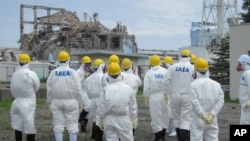Japan says it has succeeded in the first stage of a plan to stably cool damaged nuclear reactors at the Fukushima-Daiichi power plant and says it will stick to a previously declared January 2012 timetable for a cold shutdown of the reactors.
A government spokesman says authorities will also consider by January a schedule for allowing 80,000 residents evacuated from areas near the plant to return home.
The updated road map presented Tuesday in Tokyo came as Japanese officials announced a total ban on all shipments of beef cattle from Fukushima prefecture, to counter growing concerns that beef has already entered the food supply system from cattle that ate radioactive straw.
Chief Cabinet Secretary Yukio Edano said Tuesday the government will also inspect all farms in the prefecture for radiation. Agriculture Minister Michihiko Kano said earlier that authorities in all of Japan's 47 prefectures will be asked to check cattle feed for possible contamination.
Officials disclosed Monday that an additional 411 cows from seven farms in Fukushima had been shipped to market after eating rice straw contaminated with radioactive cesium released into the atmosphere by the devastating March 11 earthquake and tsunami. In some cases the contamination was more than 500 times the legal limit.
There is also evidence that cattle have been shipped after eating contaminated straw in two other prefectures. Altogether, more than 500 cows are now believed to have been shipped after eating the contaminated feed.
The cesium is believed to have been emitted into the air in the early days after Japan's March 11 earthquake and tsunami, which knocked out cooling systems at the Fukushima Daiichi plant, causing meltdowns in three reactors.
Some information for this report was provided by AP and AFP.










